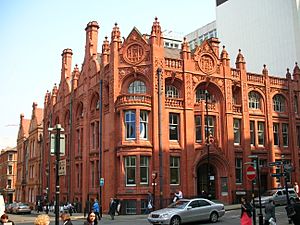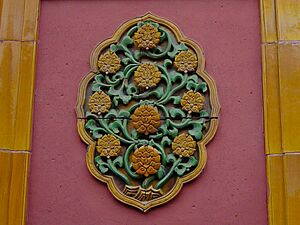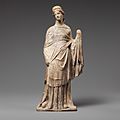Terracotta facts for kids


Terracotta is a special type of clay. It's usually red or brownish-orange. People bake it to make it hard, but they often don't put a shiny coating (called a glaze) on it.
Terracotta has been used for thousands of years! People make many things from it, like pots, water pipes, and decorations for buildings. It's also used to create amazing sculptures, such as the famous Terracotta Army in China and ancient Greek statues. The word "terracotta" can also mean the objects themselves or the reddish-brown color.
Contents
How Terracotta is Made and What it's Like
Making terracotta starts with clay. First, the clay is partly dried. Then, artists or workers shape it. They might use molds, or they might shape it by hand. After the clay is shaped, it needs to dry completely.
Once it's dry, the clay is put into a very hot oven called a kiln. Sometimes, people even fire it in a pit with burning materials. After firing, if it was in a pit, the hot terracotta is covered with sand to cool down. If it was in a kiln, the kiln is cooled slowly.
Unglazed Terracotta
When terracotta is not glazed, it's not completely waterproof. However, it's still very useful!
- It can be used underground for pipes (though this is an old way of doing things).
- It's great for garden pots and decorations.
- It works well for sculptures or building decorations in warm, tropical places.
- People also use it for oil containers, oil lamps, and ovens.
For other uses, like dishes or pipes that carry waste, terracotta usually needs a glaze. This makes it waterproof and stronger.
Terracotta's Sound and Strength
If you gently tap a piece of terracotta that isn't cracked, it will make a ringing sound. But it won't ring as brightly as a material called stoneware. Stoneware is fired at much higher temperatures. Terracotta is also not as strong as stoneware.
What's in the Clay?
Sometimes, new terracotta is made from clay that has recycled pieces of old terracotta mixed in. These recycled bits are called "grog."
Terracotta Colors
The color of unglazed terracotta can be different depending on the clay. Most clays have enough iron to make the terracotta turn orange, reddish-orange, or brownish-orange when fired. These are the colors we usually think of as "terracotta." But it can also be yellow, gray, or pink!
Images for kids
-
International Gothic Bohemian bust of the Virgin Mary; circa 1390–1395; terracotta with polychromy; 32.5 x 22.4 x 13.8 cm; Metropolitan Museum of Art (Manhattan)
-
One of the warriors of the Terracotta Army, a famous collection of Ancient Chinese terracotta sculptures depicting the armies of Qin Shi Huang, the first Emperor of China
-
The River Rhine Separating the Waters; by Claude Michel; 1765; terracotta; 27.9 × 45.7 × 30.5 cm; Kimbell Art Museum (Fort Worth, Texas, US)
-
Imperial roof decoration in the Forbidden City
-
Wealthy 'middle-class' women: so-called Tanagra figurine, ancient Greece, 325–150 BCE, Altes Museum
-
Indian terracotta figures, Gupta dynasty
-
Han dynasty tomb brick relief
-
Maximilien Robespierre, unglazed bust by Claude-André Deseine, 1791
-
The Natural History Museum in London has an ornate terracotta facade typical of high Victorian architecture. The carvings represent the contents of the Museum.
-
Modern painted horses beside a sacred tree, Tamil Nadu, India
-
The famous Terracotta artwork from Bankura, West Bengal, India
See also
 In Spanish: Terracota para niños
In Spanish: Terracota para niños




















